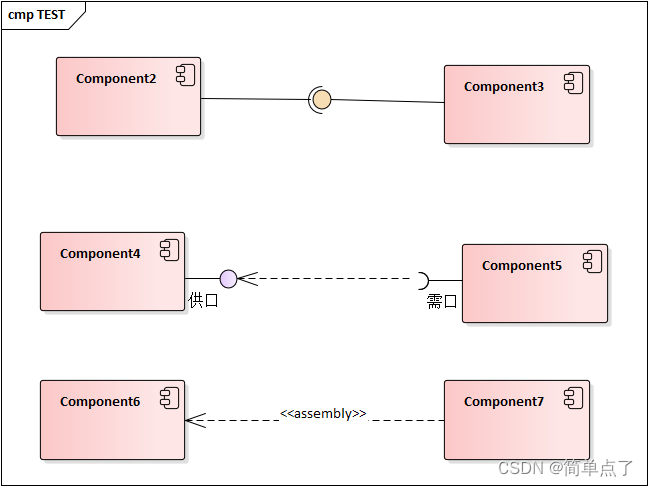旺店通app手机企业版下载冯宗耀seo教程
UML中的assembly关系
1.什么是Assembly关系
在UML(统一建模语言)中,"assembly"(组装)是一种表示组件之间关系的关联关系。组件是系统中可替换和独立的模块,可以通过组装来构建更大的系统。
当一个组件通过组装与另一个组件关联时,它表示一个组件依赖于另一个组件以实现某种功能。这种关系是一种整体与部分之间的关系,其中整体组件通过组装包含了部分组件。
通常,整体组件负责管理和协调部分组件之间的交互和通信。整体组件可以包含多个部分组件,这些部分组件可以共享资源、数据和行为。部分组件通常对整体组件是透明的,只有整体组件知道如何管理和使用它们。
在UML中,"assembly"关系可以使用实线箭头表示,箭头指向被组装的部分组件。这种关系强调了整体组件对部分组件的控制和依赖关系。
总之,"assembly"关系在UML中表示整体与部分之间的组装关系,其中整体组件通过组装包含了部分组件,整体组件负责管理和协调部分组件的交互。
2.Assembly和供需关系之间可以进行等价吗
在某些情况下,"assembly"关系和供需接口之间可以进行等价。这意味着通过适当的建模和设计,可以将一个组件的供需接口与另一个组件的组装关系等效地表示,反之亦然。
当一个组件通过组装与另一个组件关联时,可以使用供需接口的概念来描述组件之间的依赖和交互。组件的需求接口可以表示组件对其他组件提供的功能的需求,而供应接口可以表示组件向其他组件提供的功能。
从另一个角度来看,供需接口的匹配和组装关系之间的关联可以通过建模和设计进行转换。可以使用组装关系来表示一个组件通过组装包含其他组件,并通过适当的接口连接它们。反之,可以使用供需接口来描述组件之间的功能需求和提供关系。
在具体的建模和设计中,选择使用"assembly"关系或供需接口,取决于系统的需求、设计的复杂性以及设计者的偏好。无论选择哪种方式,关键是确保能够清晰地表示组件之间的依赖、交互和功能需求。
3.Assembly图示
下面显示的三种表示的方式都是可以的。

